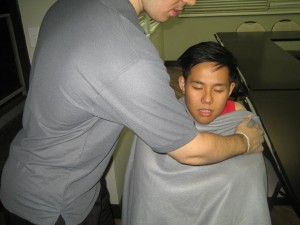In sports medicine, occasionally, the athletic trainer observes an individual sustain an injury. In many instances, however, the individual comes to the sideline, office, athletic training room, or clinic complaining of pain or discomfort. The athletic trainer should immediately assess the individual’s state of consciousness and body language, which may indicate pain, disability, fracture, dislocation, or other conditions. It also is important to note the individual’s general posture, willingness and ability to move, ease of motion, and overall attitude.
General observations may focus on the patient’s estimated age, physical condition, and personal hygiene. Potential questions to address in the observation include:

- Does the individual appear to be healthy?
- Is the individual’s weight appropriate for height, or is the individual underweight or overweight?
- Is the individual’s weight appropriate for the type and level of sport/physical activity participation?
- Could this be a contributing factor in their injury?
- Is the individual’s speech slurred, hoarse, loud, soft, incoherent, slow, fast, or hesitant?
- Is the individual hearing impaired?
- Is the individual’s hearing better through one ear?
- Is the individual oriented to the surroundings or disoriented and unaware of time or place?
- Does the individual seem to be hesitant or avoid eye contact?
By observing these factors, the skilled clinician (or any personnel with a first aid certification) can more accurately document the patient’s characteristics both quickly and accurately.
For symmetry and appearance, the body should be scanned visually to detect congenital (i.e., existing at birth) or functional problems that may be a contributing factor. This includes observing any abnormalities in the spinal curves, general symmetry of the various body parts, and general posture of the body from anterior, lateral, and posterior views.
If it is not contraindicated, the examiner should observe the normal swing of the individual’s arms and legs during walking. By standing behind, in front, and to the side of the individual, observation from all angles is permitted. A shoulder injury may be evident in a limited arm swing or by holding the arm close to the body in a splinted position. A lower extremity injury may produce a noticeable limp, or antalgic gait. Running on a treadmill can show functional problems that may have contributed to a lower extremity injury.
For motor function, many clinicians begin observation using a scan examination to assess general motor function. This examination rules out injury at other joints that may be overlooked because of intense pain or discomfort at the primary site of injury. In addition, pain in one area can be referred from another area. Observe the injured person performing gross motor movements of the neck, trunk, and extremities by asking the individual to:
(1) Extend, flex, laterally flex, and rotate the neck;
(2) Bend forward to touch the toes;
(3) Stand and rotate the trunk to the right and left;
(4) Bring the palms together above the head and then behind the back;
(5) Perform straight leg raises in hip flexion, extension, and abduction;
(6) Flex the knees; and
(7) Walk on the heels and toes.
Any hesitation by the patient to move a body part or favoring one side over the other should be noted.
Related topics:
Is CPR and First Aid Really Worth It? Read more..
